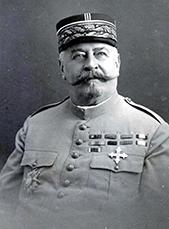Henri Mathias Berthelot

The son of a captain in the gendarmes, Henri Berthelot was born on 7 December 1861 in Feurs, in the Loire. He graduated from Saint Cyr fourth in his year, and opted to join the Colonial Army. As a sub-lieutenant in the 1st Regiment of Zouaves of Koléas, Algeria, he was sent to Indochina, where he had his baptism of fire. Promoted to lieutenant in 1886, he became a Knight of the Order of the Dragon of Annam in July 1887. A fever prompted his return to France, where he joined the 96th Infantry Regiment at Gap.
Admitted to the École Supérieure de Guerre, he obtained his General Staff Brevet and was promoted to the rank of captain in 1891. He then left for Austria to improve his German. He became General Joseph Brugère’s aide-de-camp in the 132nd Infantry Regiment at Reims, then in the 8th Army Corps at Bourges. After a spell with the 2nd Army Corps at Amiens, he was reassigned to the 132nd Infantry Regiment at Reims in 1897, then transferred to the 115th Infantry Regiment in July 1899.
Returning to General Brugère, now military governor of Paris, Berthelot supervised the organisation of the army pavilion at the 1900 Paris Exposition. Promoted to chef de bataillon (major) in November that year, he accompanied Czar Nicholas II on a visit to Reims in 1901, as Brugère’s aide-de-camp.
In 1903, he became commander of the 20th Battalion of Chasseurs à Pied in Baccarat. Recalled by Brugère in January 1906, in December he was appointed to the 2nd Bureau of the Directorate for Infantry. Made a lieutenant-colonel in March 1907, in October he became secretary of the Army Staff Technical Committee. He was promoted to colonel in 1910, and took over command of the 94th Infantry Regiment of Bar-le-Duc the following year. In 1913, he joined the staff of Joffre, the Chief of the General Staff. Involved in drawing up Plan XVII, the plan for the mobilisation and concentration of the French Army in the event of war, he did not believe the Germans would invade via Belgium.
In 1914, he was made General Joffre’s chief aide-de-camp in charge of operations. In disgrace following the failures of August, Berthelot received notice of transfer to the command of the 5th Reserve Divisions Group on 21 November. In January 1915, he led an offensive at Crouy, near Soissons. After fierce fighting, he was forced to retreat behind his starting positions.
From 3 August 1915 to 19 September 1916, he was in command of the 32nd Army Corps (32nd CA), or the “Berthelot Group”, which took part in the Champagne offensive in September-October. In March 1916, the 32nd CA was at Verdun, where it was tasked with taking back Mort-Homme and Hill 304. The 32nd CA left Verdun in June to serve in the Vosges then on the Somme.
On 14 October 1916, Berthelot led the French military mission in Romania, with nearly 2 000 officers and NCOs in his command. He reorganised the Romanian Army, which had been severely impacted by Germany and was resisting with difficulty in Moldavia. Cut off from the Allies after Russia’s withdrawal from the conflict, Romania signed the Armistice of Focșani on 9 December 1917..
Following his return to France, General Berthelot was put in command of the 5th Army by General Foch, from 5 July to 7 October 1918, taking part in the battles of Reims and Épernay.
On 7 October, he was recalled to command another Romanian mission. This time, his role was as much diplomatic as military. Now with a modernised and reorganised army, Romania took up arms once again on 10 November, just as the Central Empires were crumbling. This new military intervention succeeded in containing the pressure from the Russian Revolution in the Balkans, as well as satisfying certain Romanian claims, namely regarding Transylvania and northern Banat.
Following the German defeat, Berthelot was tasked with fighting the Russian Bolsheviks in Bessarabia, then the Hungarian Bolsheviks in Transylvania during the Hungarian-Romanian War of 1919. He went on to become military governor of Metz until 1922, then of Strasbourg from 1923 to 1926.
He died in Paris in January 1931, and is buried in Nervieux, in his native Forez.
He was awarded the Grand Cross of the Légion d’Honneur, the Croix de Guerre 1914-1918 with three palms, the Médaille Militaire, the 1914-1918 Inter-Allied Victory Medal, as well as many foreign decorations.

